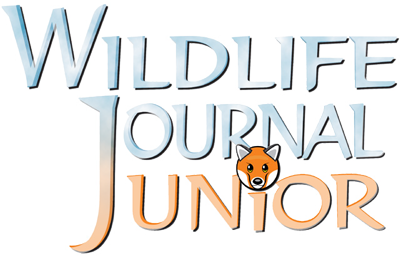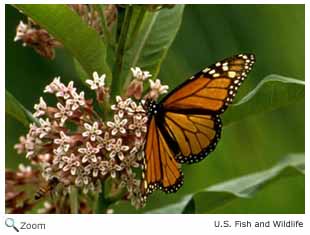Additional Information
Key:  Profile Profile  Photos Photos  Video Video  Audio Audio  NH Species NH Species
American Lady - Vanessa virginiensis   
The American lady butterfly feeds on nectar from dogbane, aster, goldenrod, marigold, selfheal, and common milkweed.
Source: Butterflies and Moths of North America Intended Audience: General Reading Level: Middle School
American Snout - Libytheana carinenta   
The American snout butterfly feeds on aster, dogbane, dogwood, goldenrod,and sweet pepperbush.
Source: Butterflies and Moths of North America Intended Audience: General Reading Level: Middle School
Aphrodite Fritillary - Speyeria aphrodite   
The Aphrodite fritillary is found in moist prairies, high mountain meadows, openings in barrens, brushland, dry fields, open oak woods, and bogs.
Source: Butterflies and Moths of North America Intended Audience: General Reading Level: Middle School
Appalachian Brown - Satyrodes appalachia   
The Appalachian brown caterpillar feeds on sedge and giant sedge.
Source: Butterflies and Moths of North America Intended Audience: General Reading Level: Middle School
Arctic Fritillary - Boloria chariclea   
The Arctic fritillary butterfly feeds on goldenrods and asters.
Source: Butterflies and Moths of North America Intended Audience: General Reading Level: Middle School
Astyanax Red-spotted Purple - Limenitis arthemis astyanax  
The Astyanax red-spotted purple is an iridescent blue with reddish-orange spots.
Source: Butterflies and Moths of North America Intended Audience: General Reading Level: Middle School
Atlantis Fritillary - Speyeria atlantis   
The Atlantis fritillary caterpillar feeds on violets.
Source: Butterflies and Moths of North America Intended Audience: General Reading Level: Middle School
Baltimore - Euphydryas phaeton   
The Baltimore butterfly is black with red-orange crescents on the outer margins of both wings and rows of creamy white spots on the interior of its upper wings.
Source: Butterflies and Moths of North America Intended Audience: General Reading Level: Middle School
Common Buckeye - Junonia coenia   
The common buckeye has a series of large eyespots on its wings.
Source: Butterflies and Moths of North America Intended Audience: General Reading Level: Middle School
Common Ringlet - Coenonympha tullia   
The common ringlet caterpillar eats grasses and rushes.
Source: Butterflies and Moths of North America Intended Audience: General Reading Level: Middle School
Common Wood Nymph - Cercyonis pegala   
The common wood nymph butterfly feeds on rotting fruit and flower nectar.
Source: Butterflies and Moths of North America Intended Audience: General Reading Level: Middle School
Compton Tortoiseshell - Nymphalis vaualbum   
The Compton tortoiseshell gets its name from the orange and brown tortoiseshell like pattern on its wings.
Source: Butterflies and Moths of North America Intended Audience: General Reading Level: Middle School
Eastern Comma - Polygonia comma   
The eastern comma butterfly eats rotting fruit and tree sap.
Source: Butterflies and Moths of North America Intended Audience: General Reading Level: Middle School
Eyed Brown - Satyrodes eurydice   
The eyed brown butterfly eats sap, bird droppings, and occasionally flower nectar.
Source: Butterflies and Moths of North America Intended Audience: General Reading Level: Middle School
Gray Comma - Polygonia progne   
The gray comma is bright orange on its upperside and gray on its underside.
Source: Butterflies and Moths of North America Intended Audience: General Reading Level: Middle School
Great Spangled Fritillary - Speyeria cybele   
The great spangled fritillary caterpillar feeds on various violet plants.
Source: Butterflies and Moths of North America Intended Audience: General Reading Level: Middle School
Green Comma - Polygonia faunus   
The green comma butterfly eats flower nectar, dung, and carrion.
Source: Butterflies and Moths of North America Intended Audience: General Reading Level: Middle School
Harris' Checkerspot - Chlosyne harrisii   
Harris' checkerspot caterpillar feeds on the flat-topped white aster.
Source: Butterflies and Moths of North America Intended Audience: General Reading Level: Middle School
Hoary Comma - Polygonia gracilis   
Currants, gooseberries, western azalea, and mock azalea are the host plants for the hoary comma caterpillar.
Source: Butterflies and Moths of North America Intended Audience: General Reading Level: Middle School
Jutta Arctic - Oeneis jutta   
The Jutta Arctic is found in wet tundra, spruce bogs, and lodgepole pine forests.
Source: Butterflies and Moths of North America Intended Audience: General Reading Level: Middle School
Little Wood Satyr - Megisto cymela   
The little wood satyr is light brown with a series of eyespots on the edges of its wings.
Source: Butterflies and Moths of North America Intended Audience: General Reading Level: Middle School
Meadow Fritillary - Boloria bellona   
The meadow fritillary butterfly feeds on black-eyed susans, dandelions, and ox-eyed daisies.
Source: Butterflies and Moths of North America Intended Audience: General Reading Level: Middle School
Melissa Arctic - Oeneis melissa   
A subspecies of the Melissa Arctic, the Oeneis melissa semidea, is found in the White Mountains of New Hampshire.
Source: Butterflies and Moths of North America Intended Audience: General Reading Level: Middle School
Milbert's Tortoiseshell - Aglais milberti   
Milbert's tortoiseshell is black with an orange band on the edges of its wings.
Source: Butterflies and Moths of North America Intended Audience: General Reading Level: Middle School
Monarch - Danaus plexippus   
The monarch butterfly feeds on nectar from milkweed.
Source: Butterflies and Moths of North America Intended Audience: General Reading Level: Middle School
Monarch - Danaus plexippus   
There are two distinct populations of monarch butterflies in North America.
Source: Animal Diversity Web Intended Audience: General Reading Level: Middle School
Monarch - Danaus plexippus    
During the winter, monarch butterflies hibernate in fir, pine, oak and cedar forests.
Source: Arkive Intended Audience: General Reading Level: Middle School
Mourning Cloak - Nymphalis antiopa   
The mourning cloak is purplish-black with a wide, bright yellow border on outer margins of its wings.
Source: Butterflies and Moths of North America Intended Audience: General Reading Level: Middle School
Northern Crescent - Phyciodes cocyta   
The northern crescent butterfly feeds on flowers of dogbane, fleabane, and white clover.
Source: Butterflies and Moths of North America Intended Audience: General Reading Level: Middle School
Northern Pearly Eye - Enodia anthedon   
The northern pearly eye butterfly feeds on dung, fungi, carrion, and sap from willows, poplars, and birch.
Source: Butterflies and Moths of North America Intended Audience: General Reading Level: Middle School
Painted Lady - Vanessa cardui   
The painted lady is found on all continents except Australia and Antarctica.
Source: Butterflies and Moths of North America Intended Audience: General Reading Level: Middle School
Painted Lady - Vanessa cardui    
The painted lady is orange and black with white spots.
Source: Arkive Intended Audience: General Reading Level: Middle School
Pearl Crescent - Phyciodes tharos   
The pearl crescent is found in pastures, road edges, vacant lots, fields, and open pine woods.
Source: Butterflies and Moths of North America Intended Audience: General Reading Level: Middle School
Question Mark - Polygonia interrogationis   
The question mark butterfly feeds on rotting fruit, tree sap, dung, carrion.
Source: Butterflies and Moths of North America Intended Audience: General Reading Level: Middle School
Red Admiral - Vanessa atalanta   
The red admiral butterfly feeds on sap flows on trees, fermenting fruit, and bird droppings.
Source: Butterflies and Moths of North America Intended Audience: General Reading Level: Middle School
Red Admiral - Vanessa atalanta    
The red admiral butterfly is found in Europe, Asia, North Africa and North America.
Source: Arkive Intended Audience: General Reading Level: Middle School
Red-spotted Purple or White Admiral - Limenitis arthemis   
The red-spotted purple or white admiral was once thought to be two separate species instead of variations of one species.
Source: Butterflies and Moths of North America Intended Audience: General Reading Level: Middle School
Regal Fritillary - Speyeria idalia   
The regal fritillary butterfly feeds on nectar from flowers of milkweeds, thistles, red clover, and mountain mint.
Source: Butterflies and Moths of North America Intended Audience: General Reading Level: Middle School
Satyr Comma - Polygonia satyrus   
The satyr comma butterflies feed on tree sap, rotting fruit, and flower nectar.
Source: Butterflies and Moths of North America Intended Audience: General Reading Level: Middle School
Silver-bordered Fritillary - Boloria selene   
The silver-bordered fritillary is found in wet meadows, bogs, and marshes.
Source: Butterflies and Moths of North America Intended Audience: General Reading Level: Middle School
Silvery Checkerspot - Chlosyne nycteis   
The silvery checkerspot butterflies are found in streamsides, meadows, and forest openings.
Source: Butterflies and Moths of North America Intended Audience: General Reading Level: Middle School
Tawny Crescent - Phyciodes batesii   
The tawny crescent is found in moist meadows and pastures in the northern part of its range and dry rocky ridges or hillsides in the southern part of its range.
Source: Butterflies and Moths of North America Intended Audience: General Reading Level: Middle School
Variegated Fritillary - Euptoieta claudia   
The variegated fritillary is orange with thick dark veins and markings and black spots near the margin of its wings.
Source: Butterflies and Moths of North America Intended Audience: General Reading Level: Middle School
Variegated Fritillary - Euptoieta claudia  
The variegated fritillary is has two to three broods a year.
Source: Massachusetts Butterfly Club Intended Audience: General Reading Level: Middle School
Viceroy - Limenitis archippus   
The viceroy looks like the monarch butterfly.
Source: Butterflies and Moths of North America Intended Audience: General Reading Level: Middle School |


